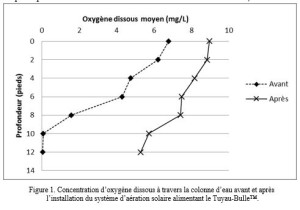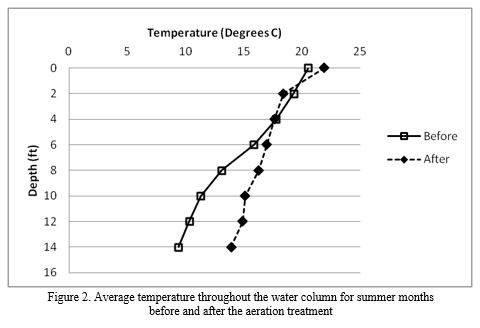Trout Pond Regeneration with Solar Aeration System
Summary
A case was presented to Canadianpond in 2014 where a trout pond had high organic matter input, high dissolved organic carbon and low dissolved oxygen concentrations. The goal of managing the pond was to improve water quality conditions for the trout population. This project was a success and we tell you about it.
Trout Pond Regeneration with Solar Aeration System – short (PDF)
Trout Pond Issue
The targeted issue for this project was to increase dissolved oxygen (DO) concentrations throughout the water column to expand trout habitat and improve overall water quality. The clarity of the lake was minimal due to a high dissolved organic carbon (DOC) concentration in the water, however algae growth was not an issue. This suggested that oxygen uptake in the lake came from decomposition of older, possibly allochthonous, sediments rather than algae respiration.
Reports from the owner suggested that the trout population was diminishing at an alarming rate, with no obvious signs of fish kills. The disappearance of fish could have been linked to predation, however regardless of the cause, the lack of refugia within the trout pond was most likely the root of the problem.
Trout need a minimum dissolved oxygen concentration of 4 mg/L to live and develop well. Deep layers are often very poor in oxygen when thermal stratification is present during summer or winter. This is precisely the biggest problem: The upper water layer (epilimnion) becomes too warm in summer for the trout to live in (trout live in cold water and die when the water reaches 23 °C). As a consequence, fish are unable to live either at the bottom due to lack of oxygen nor at the surface due to too much heat, but only in a very small layer of habitable water between the two clines.
Treatment
 Using this framework as a basis for further treatment options Canadianpond.ca sampled the lake prior to any treatment.
Using this framework as a basis for further treatment options Canadianpond.ca sampled the lake prior to any treatment.
Upon first sampling, it was found that the average maximum depth where dissolved oxygen concentrations were viable for trout was 1.8 m (6 ft) whereas the average depth was around 4 m (13 ft).
The water temperature was also measured as a function of depth.
Treatments applied
Aeration options were limitd by lack of electricity at the site. Our solution was to add a solar powered bottom aeration system fitted with a diffuser. The system was installed in the early summer of 2014 and follow-up sampling was done later that summer and once more in 2015.
Results
 Dissolved oxygen showed a significant improvement from before and after treatment in all sampled stations (Figure 1).
Dissolved oxygen showed a significant improvement from before and after treatment in all sampled stations (Figure 1).
In order to check to make sure that most of the water column stays below 21 °C, the average water temperature during the summer months was calculated throughout all of the sampling points and dates (Figure 2). As expected, there is much less stratification after treatment and the water at the bottommost depths is much warmer than before the treatment. Even though temperatures are warmer, the entire water column, except for the surface, remains under the 21 °C required for the viability of the trout.
Conclusion
The treatment expanded the habitat of the trout by 55% to include the entire pond. Canadianpond considers this project to have met all the goals defined, therefore a complete success.
References
Casselman, J. (2013) Haliburton’s Lake Trout: From the Past Into the Future. Presentation. Queen’s University, Kingston, Ontario, Canada.